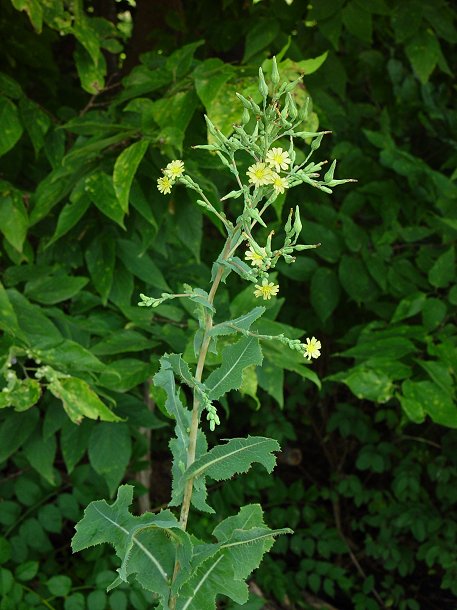Lactuca serriola L.
Prickly Lettuce

Introduced
CC = *
CW = 3
MOC = 60
© DETenaglia
Lactuca serriola L.Prickly Lettuce | |
 |
Introduced CC = * CW = 3 MOC = 60 |
© DETenaglia |
|
Family - Asteraceae/Cichorieae Habit - Annual or biennial forb with white, milky sap. Stems - Ascending to erect, to 2.0 m, single from the base, hollow between the nodes, glabrous above, typically hispid near the base, glaucous or not, whitish tan, with sap which is pure white.
Leaves - Alternate, sessile or with a winged petiole, well developed along the stems, highly variable. Basal and lower stem leaves mostly 15-20 cm long, narrowly oblong to ovate in outline, usually deeply pinnately lobed, the margins sharply toothed and prickly but otherwise glabrous, usually with a pair of narrowly to broadly triangular basal lobes clasping the stem, the surfaces glabrous but the undersurface prickly along the midvein. Sinuses of lobes typically rounded. Middle and upper stem leaves mostly linear to lanceolate, unlobed, the margins sometimes lacking teeth but with short prickles, the base more or less rounded, with a pair of narrowly triangular basal lobes clasping the stem, the undersurface usually short-prickly along the midvein.
Inflorescences - Mostly well-branched panicles with 50-100 or more heads, the axis glabrous. Inflorescence branches subtended by a clasping bract.
Heads - Ligulate. Involucre narrowly cup-shaped to cylindrical or urn-shaped, 7-8 mm long at flowering, elongating to 10-15 mm at fruiting, the bracts 17-19. Phyllaries imbricate, unequal, the innermost the longest, to 8 mm long.
Flowers - Ray florets 18-24 per head, fertile. Corollas 5-notched at the apex, glabrous, light yellow to lemon yellow, occasionally bluish-or purplish-tinged on the outer surface, sometimes turning blue with age or upon drying. Corolla tube whitish, 4 mm long, glabrous but with a ring of hairs at the apex. Stamens 5, adnate at the apex of the corolla tube, glabrous, 1.5 mm long, pale yellow. Anthers yellow, connate around the style, exserted. Style exserted beyond the anthers,Pappus of capillary bristles 4-5 mm long. Disk flowers absent. Fruits - Achenes with the body 3-4 mm long, 1.5-2.0 mm wide, yellowish brown to grayish brown, somewhat flattened, short-bristly toward the tip, angled along the margins and with 5-7 roughened to minutely awned nerves or ridges on each face, tapered to a slender beak 1-2 times as long as the body.
Flowering - July - October. Habitat - Streambanks, pond margins, forest openings, upland prairies, fields, pastures, roadsides, railroads, open disturbed areas. Origin - Native to Europe. Lookalikes - Other species of Lactuca, particularly L. canadensis and L. saligna. More broadly, numerous plants in the Cichorieae section of the Asteraceae. Other info. - This species can be found throughout Missouri and the entire continental U.S. The plant is easy to identify from its pure white sap (with no trace of tan or orange tint), prickly leaves, and yellow flowers. It is quite weedy and is most typically found in highly disturbed areas. Varieties have been named based upon leaf lobing, with var. integrifolia (Bogenh.) G. Beck having unlobed leaves and var. serriola having the more characteristic and common, pinnately lobed leaves. Photographs taken in Ellington, MO., 7-13-03 (DETenaglia); also near Labadie, Franklin County, MO, 7-15-2007, and along the Katy Trail near Dutzow, Warren County, MO, 7-1-2020 and 7-12-2022 (SRTurner). |